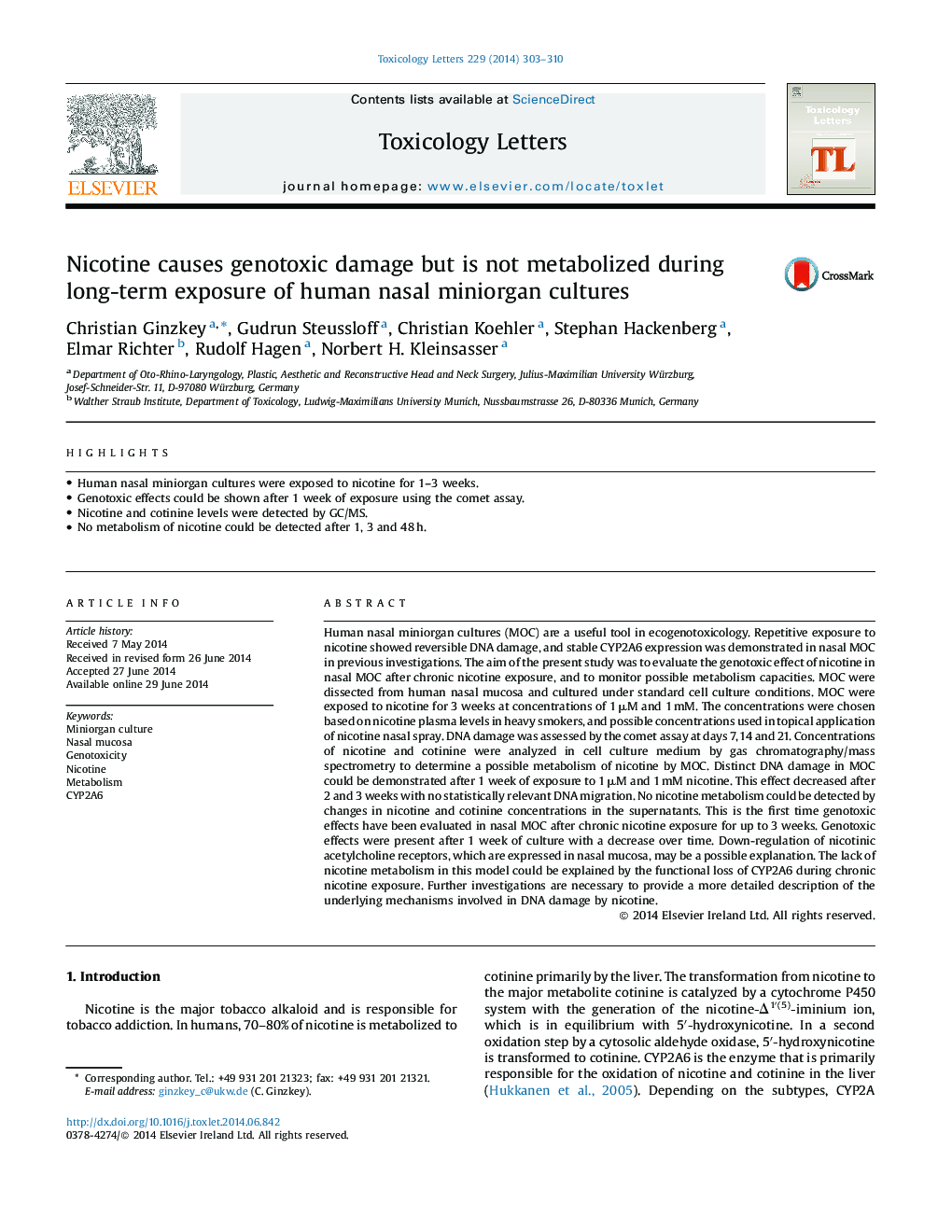| کد مقاله | کد نشریه | سال انتشار | مقاله انگلیسی | نسخه تمام متن |
|---|---|---|---|---|
| 5860298 | 1133172 | 2014 | 8 صفحه PDF | دانلود رایگان |
عنوان انگلیسی مقاله ISI
Nicotine causes genotoxic damage but is not metabolized during long-term exposure of human nasal miniorgan cultures
ترجمه فارسی عنوان
نیکوتین سبب آسیب ژنوتوکسیک می شود، اما در طول مدت دراز مدت در معرض کشت مینیورگان انسان بینی متابولیزه نمی شود
دانلود مقاله + سفارش ترجمه
دانلود مقاله ISI انگلیسی
رایگان برای ایرانیان
کلمات کلیدی
موضوعات مرتبط
علوم زیستی و بیوفناوری
علوم محیط زیست
بهداشت، سم شناسی و جهش زایی
چکیده انگلیسی
Human nasal miniorgan cultures (MOC) are a useful tool in ecogenotoxicology. Repetitive exposure to nicotine showed reversible DNA damage, and stable CYP2A6 expression was demonstrated in nasal MOC in previous investigations. The aim of the present study was to evaluate the genotoxic effect of nicotine in nasal MOC after chronic nicotine exposure, and to monitor possible metabolism capacities. MOC were dissected from human nasal mucosa and cultured under standard cell culture conditions. MOC were exposed to nicotine for 3 weeks at concentrations of 1 μM and 1 mM. The concentrations were chosen based on nicotine plasma levels in heavy smokers, and possible concentrations used in topical application of nicotine nasal spray. DNA damage was assessed by the comet assay at days 7, 14 and 21. Concentrations of nicotine and cotinine were analyzed in cell culture medium by gas chromatography/mass spectrometry to determine a possible metabolism of nicotine by MOC. Distinct DNA damage in MOC could be demonstrated after 1 week of exposure to 1 μM and 1 mM nicotine. This effect decreased after 2 and 3 weeks with no statistically relevant DNA migration. No nicotine metabolism could be detected by changes in nicotine and cotinine concentrations in the supernatants. This is the first time genotoxic effects have been evaluated in nasal MOC after chronic nicotine exposure for up to 3 weeks. Genotoxic effects were present after 1 week of culture with a decrease over time. Down-regulation of nicotinic acetylcholine receptors, which are expressed in nasal mucosa, may be a possible explanation. The lack of nicotine metabolism in this model could be explained by the functional loss of CYP2A6 during chronic nicotine exposure. Further investigations are necessary to provide a more detailed description of the underlying mechanisms involved in DNA damage by nicotine.
ناشر
Database: Elsevier - ScienceDirect (ساینس دایرکت)
Journal: Toxicology Letters - Volume 229, Issue 1, 17 August 2014, Pages 303-310
Journal: Toxicology Letters - Volume 229, Issue 1, 17 August 2014, Pages 303-310
نویسندگان
Christian Ginzkey, Gudrun Steussloff, Christian Koehler, Stephan Hackenberg, Elmar Richter, Rudolf Hagen, Norbert H. Kleinsasser,
